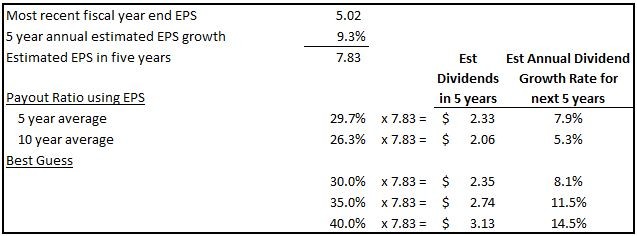Dividend Payout Ratio Definition Example
Post on: 17 Июнь, 2015 No Comment

What it is:
The dividend payout ratio measures the percentage of a company’s net income that is given to shareholders in the form of dividends.
How it works/Example:
The dividend payout ratio is a relatively simple calculation:
Total Annual Dividends Per Share / Diluted Earnings Per Share
Why it Matters:
While some investors prefer that a company reinvest its earnings back into the business to fuel future growth, many appreciate a generous cash dividend payment — particularly since tax legislation enacted in 2003 has given dividends a tax-advantaged status. However, this legislation is set to expire in 2011, and dividend taxation rates will return to their pre-2001 levels.

For income-oriented investors, the dividend payout ratio is a closely-watched financial measure. Dividend payout ratios provide valuable insight into a company’s dividend policy and can also reveal whether those payments appear safe or are in jeopardy of possibly being reduced. In the example of XYZ above, a ratio of 10% means that shareholders are only receiving a dime for every dollar the company is earning. In this case, the company is generating ample profits to support this relatively modest payment. In fact, if management considered it in the best interests of the company, it could probably afford to raise its dividend payment significantly.
On the other hand, an excessively high payout ratio suggests that the company might be paying out more than it can comfortably afford. Not only does this leave just a small percentage of profits to plow back into the business, but it also leaves the firm highly susceptible to a decline in future dividend payments. In some cases, a company will even pay out more than it earns, thus yielding a dividend payout ratio in excess of 100%. Such extremely high payouts are rarely sustainable and should warn investors that a dividend cut may be on the horizon. Because the act of reducing dividends is usually interpreted as a sign of weakness, when a dividend cut announcement is made, it also usually triggers a decline in the share price. Even if management finds a way to maintain an extremely high dividend payout ratio for an extended period of time, this strategy usually results in either a dwindling cash position or a rising debt load .
It should be noted, also, that dividend payout ratios can be impacted by a number of factors. For example, different accounting methods yield different earnings per share figures, which in turn influence the ratio. Furthermore, businesses in different growth stages can be expected to have different dividend policies. Young, fast-growing companies are typically focused on reinvesting earnings in order to grow the business. As such, they generally sport low (or even zero) dividend payout ratios. At the same time, larger, more-established companies can usually afford to return a larger percentage of earnings to stockholders.
When comparing dividend payout ratios, you should also remember that they will vary widely according to industry. For example, where many high-tech sectors often distribute small or non-existent dividends, banks and utilities typically pay out a healthy chunk of their gains each year. Also, companies operating in some industries — such as real estate investment trusts (REITs) — are required by law to distribute a certain percentage of earnings (this figure now sits at 90% for REITs). For this reason, it can be misleading to compare the ratios of companies operating in different industries. When applied correctly, though, dividend payout ratios can be a powerful analytical tool.














